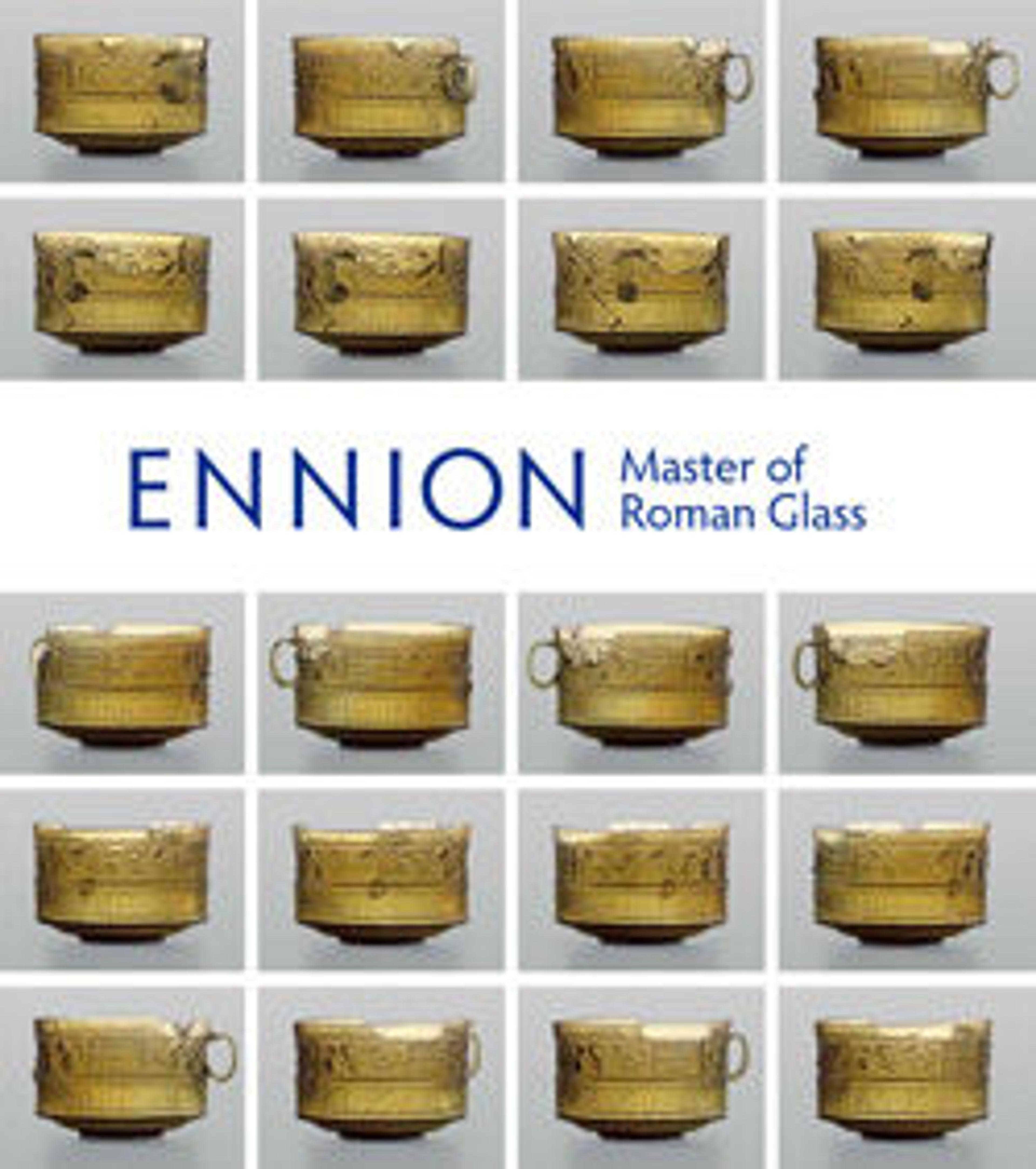Glass cup
Translucent yellow green with same color handles.
Unworked vertical rim of varying thickness; cylindrical body with vertical sides; bottom with S-shaped curve around outer section, then a projecting circular base with raised outer band but concave with slight kick in center; two loop handles attached to sides over upper decorative frieze.
Body decorated with a plain band below rim above two horizontal friezes in relief; on the upper, which is bounded above and below by a fine raised line, two Greek inscriptions, each within a tabula ansata; one flanked by ivy sprays with leaves and berries and the other by vine sprays with leaves and bunches of grapes; both sets of foliage issuing from two vertically fluted colonettes with base and Ionic capital, set at sides near handles; dividing the upper from the lower frieze, a broad projecting horizontal ridge; on the lower frieze, close-set vertical flutes, rounded at both ends; on outer section of bottom, a diagonal net pattern; three raised concentric circles and central dot on base.
Broken and cracked, with one handle missing and large gap and two smaller chips in rim; a few pinprick bubbles; faint weathering and iridescence.
Sides blown in a three-part mold, with mold marks extending to ridge below vertical flutes; separate saucer-shaped mold for underside and bottom.
Mold-blowing developed in the early decades of the first century A.D. as an offshoot of free-blowing. The earliest makers of mold-blown glass probably came from the Syro-Palestinian region, although their wares quickly became popular throughout the Roman Empire. The most famous and attractive vessels are signed in Greek by Ennion; about thirty examples of his work survive today. These three vessels show the variety of forms and fine decorated details that Ennion's workshop produced.
Unworked vertical rim of varying thickness; cylindrical body with vertical sides; bottom with S-shaped curve around outer section, then a projecting circular base with raised outer band but concave with slight kick in center; two loop handles attached to sides over upper decorative frieze.
Body decorated with a plain band below rim above two horizontal friezes in relief; on the upper, which is bounded above and below by a fine raised line, two Greek inscriptions, each within a tabula ansata; one flanked by ivy sprays with leaves and berries and the other by vine sprays with leaves and bunches of grapes; both sets of foliage issuing from two vertically fluted colonettes with base and Ionic capital, set at sides near handles; dividing the upper from the lower frieze, a broad projecting horizontal ridge; on the lower frieze, close-set vertical flutes, rounded at both ends; on outer section of bottom, a diagonal net pattern; three raised concentric circles and central dot on base.
Broken and cracked, with one handle missing and large gap and two smaller chips in rim; a few pinprick bubbles; faint weathering and iridescence.
Sides blown in a three-part mold, with mold marks extending to ridge below vertical flutes; separate saucer-shaped mold for underside and bottom.
Mold-blowing developed in the early decades of the first century A.D. as an offshoot of free-blowing. The earliest makers of mold-blown glass probably came from the Syro-Palestinian region, although their wares quickly became popular throughout the Roman Empire. The most famous and attractive vessels are signed in Greek by Ennion; about thirty examples of his work survive today. These three vessels show the variety of forms and fine decorated details that Ennion's workshop produced.
Artwork Details
- Title: Glass cup
- Period: Early Imperial, Julio-Claudian
- Date: 1st half of 1st century CE
- Culture: Roman
- Medium: Glass; blown in a four-part mold
- Dimensions: Other: 2 7/16 × 4 3/8 in. (6.2 × 11.1 cm)
Diam. of rim: 3 13/16 in. (9.7 cm)
Diam. of foot: 1 7/8 in. (4.8 cm) - Classification: Glass
- Credit Line: Gift of J. Pierpont Morgan, 1917
- Object Number: 17.194.225
- Curatorial Department: Greek and Roman Art
More Artwork
Research Resources
The Met provides unparalleled resources for research and welcomes an international community of students and scholars. The Met's Open Access API is where creators and researchers can connect to the The Met collection. Open Access data and public domain images are available for unrestricted commercial and noncommercial use without permission or fee.
To request images under copyright and other restrictions, please use this Image Request form.
Feedback
We continue to research and examine historical and cultural context for objects in The Met collection. If you have comments or questions about this object record, please contact us using the form below. The Museum looks forward to receiving your comments.
